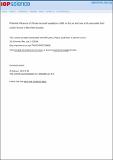Potential influence of climate-induced vegetation shifts on future land use and associated land carbon fluxes in Northern Eurasia
Author(s)
Kicklighter, David; Zhuang, Q.; Parfenova, E. I.; Melillo, Jerry M.; Tchebakova, N. M.; Lu, X.; Cai, Yongxia; Paltsev, Sergey; Sokolov, Andrei P; Reilly, John M; ... Show more Show less
DownloadKicklighter-2014-Potential influence.pdf (1.634Mb)
PUBLISHER_CC
Publisher with Creative Commons License
Creative Commons Attribution
Terms of use
Metadata
Show full item recordAbstract
Climate change will alter ecosystem metabolism and may lead to a redistribution of vegetation and changes in fire regimes in Northern Eurasia over the 21st century. Land management decisions will interact with these climate-driven changes to reshape the region's landscape. Here we present an assessment of the potential consequences of climate change on land use and associated land carbon sink activity for Northern Eurasia in the context of climate-induced vegetation shifts. Under a 'business-as-usual' scenario, climate-induced vegetation shifts allow expansion of areas devoted to food crop production (15%) and pastures (39%) over the 21st century. Under a climate stabilization scenario, climate-induced vegetation shifts permit expansion of areas devoted to cellulosic biofuel production (25%) and pastures (21%), but reduce the expansion of areas devoted to food crop production by 10%. In both climate scenarios, vegetation shifts further reduce the areas devoted to timber production by 6–8% over this same time period. Fire associated with climate-induced vegetation shifts causes the region to become more of a carbon source than if no vegetation shifts occur. Consideration of the interactions between climate-induced vegetation shifts and human activities through a modeling framework has provided clues to how humans may be able to adapt to a changing world and identified the trade-offs, including unintended consequences, associated with proposed climate/energy policies.
Date issued
2014-03Department
Massachusetts Institute of Technology. Center for Global Change Science; Massachusetts Institute of Technology. Joint Program on the Science & Policy of Global Change; MIT Energy InitiativeJournal
Environmental Research Letters
Publisher
IOP Publishing
Citation
Kicklighter, D W, Y Cai, Q Zhuang, E I Parfenova, S Paltsev, A P Sokolov, J M Melillo, J M Reilly, N M Tchebakova, and X Lu. “Potential Influence of Climate-Induced Vegetation Shifts on Future Land Use and Associated Land Carbon Fluxes in Northern Eurasia.” Environmental Research Letters 9, no. 3 (March 1, 2014): 035004. © 2014 IOP Publishing Ltd
Version: Final published version
ISSN
1748-9326